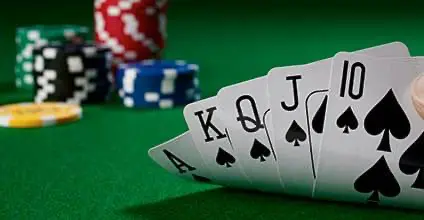How to Play Poker

Poker Basics
Poker Game Rules
Why Play Online Poker at Bovada
Welcome to Bovada Poker. You have arrived at the No. 1 online poker room for players in the United States, with the best software, the deepest player pools, and the most reliable payouts in the business. This guide will show you how to play online poker at Bovada, focusing on the basic rules and some simple strategies you can learn to use right away at the tables – whether you’re a beginner or a more advanced player. But first, here’s a closer look at what makes Bovada your top choice for real money poker in USA.
US players have been waiting for a second online poker boom for a while now. But there’s no need to wait: Bovada Poker’s origin story dates back to 2004 when the first boom was just getting started. Nobody else can offer the same track record of customer satisfaction that Bovada has built over the years. When you join Bovada Poker, you’ll have access to an established player pool of recreational and professional players across the entire PaiWangLuo Network. The games are great, and they run around the clock, with Texas Hold’em, Omaha and Omaha Hi/Lo all on the menu.
Top Poker Features at Bovada
When you download the poker client for Bovada, you’ll have a world of special features at your fingertips. You can choose enhanced animations and layouts, the very useful four-color deck, and the world-famous Rabbit Card feature. You can even play online casino games without leaving the client. Click here to check out our full list of special features at Bovada Poker.
How to Play Mobile Poker
If you’ve already left your desktop behind like many players have, no problem: You can play real money poker at Bovada using your mobile device. We have the best poker web app in North America, allowing you to play poker instantly without having to download anything. Just log in at http://m.bovada.lv/poker from your smartphone or tablet and jump right in. You’ll be able to play the full lineup of cash games at Bovada Poker, as well as the new Jackpot Sit-and-Gos.
Poker Game Rules
There are lots of different ways to play poker, but they share the same fundamental rules. All three “flop” games at Bovada Poker use the standard 52-card French deck, with Aces counting as either high or low. You and your fellow players will sit around a virtual poker table, taking turns clockwise, and each of you will have a stack of poker chips to play with. At the start of a poker hand, everyone will be dealt a certain number of hole cards: two for Texas Hold’em, four for Omaha and Omaha Hi/Lo. Then people will place bets if they want to, using the chips in front of them. The object is twofold: Either make the best five-card poker hand or get everyone else to fold. You’ll find the standard hands rankings for poker right here.
So how do you make a five-card poker hand with only two (or four) hole cards? That’s where the community cards come into play. There are four possible betting rounds in each hand; after the first round of betting, if there are still at least two players in the pot, the Dealer will place three cards face-up in the middle of the table. These three cards (also known as the flop) are available for all players to use. If required, a fourth card (the turn) and a fifth card (the river) will be revealed, each with its own round of betting.
The betting is what makes poker the great game it is. Generally speaking, you have five plays at your disposal when you play poker: bet, raise, call, check, or fold. Betting is when you’re the first player to put money in the pot during the current round. Raising is when you bet a larger amount than what someone else has already put in. Calling is when you match that other player’s bet. Checking is when you choose to bet zero chips, and folding is when you choose to exit the hand. Pick the right play – and pick the right number of chips when you’re betting or raising – and you’ll give yourself the best chance to win the pot.
How many chips you’re allowed to bet or raise will be pre-determined by the betting structure in play. There are three different betting limits in poker: Fixed-Limit, Pot-Limit, and No-Limit. In Fixed-Limit games (also known as “Limit” for short), the only possible bet sizes are the small bet, which is used pre-flop and on the flop, and the big bet, which is used on the turn and river. The small bet is the size of the big blind – which we’ll explain further in a moment – and the big bet is twice the size of the small bet. This is the old-school way to play Hold’em and remains the preferred way to play Omaha Hi/Lo.
Omaha, on the other hand, is most commonly played using the Pot-Limit structure. In Pot-Limit games, the largest bet (or raise) you can make is the size of the pot. And in No-Limit, easily the most popular way to play Texas Hold’em, you can bet your entire stack when it’s your turn. As you move from Fixed-Limit to Pot-Limit to No-Limit, the pots get larger and larger, and the action gets hot and heavy. Make sure you’re aware of which limit your chosen game is using before you start playing.
Also, make sure you know the subtle rule difference between Texas Hold’em and the Omaha variants. In Hold’em, you can make your 5-card poker hand using either, both, or none of your hole cards. In Omaha, you have to use exactly two hole cards. This can be a little tricky for newer players. If there are five Spades on the board in Omaha, and you don’t have any Spades in your hole cards, you don’t have a flush.
Once you’ve figured out those rules, here’s a special twist: In Omaha Hi/Lo, you’re trying to make the worst poker hand as well as the best poker hand. It’s a split-pot game, where half the pot goes to the High hand, and the other half to the Low hand – provided there is one. All five cards in the Low hand have to be Eight or lower in value. If there isn’t a qualifying Low, the High scoops the pot. You can use two different hole cards for your Low and your High if you want. In all three of these flop games, if two or more players have the same hand strength, it’s a chopped pot, divided evenly among the winners.
Online Poker Basics
On top of the standard poker rules, there are special poker terms that people use to describe the game. Each seat at the table has its own name, starting with the small blind and the big blind. These are the two players who are forced to place some chips in front of them before every hand, to keep the action going. The small blind is seated to the right of the big blind. Assuming there are more than two players in the game, the next person to the right is the button, followed by the cut-off, the hijack, and the LoJack in a 6-max game. In a full-ring game, the next three players are referred to as under the gun minus-2 (UTG –2), under the gun minus-1 (UTG –1), and under the gun (UTG).
There are also different structures in place for cash games and poker tournaments. Cash games are when you exchange your money for chips, and you can win or lose chips on every single hand you play. Tournaments ask you to pay a buy-in and an entry fee, after which you receive a certain number of chips that don’t have specific monetary value. Then you and your opponents play poker until everyone runs out of chips and the winner is declared. The buy-ins are placed in a prize pool and split among the longest survivors, with the top prize going to the last player standing.
Online Poker Strategy
Because poker is a game of skill as well as luck, you can improve your chances of winning by employing a little strategy. This strategy will depend on things like your position at the table, the stack sizes involved, and whether you’re playing a cash game or a tournament. You’ll also base your decisions on the strength of your hand (or better still, the strength of your possible hands), the strength of your opponents, and the pot odds – the ratio between the size of the pot and the size of your potential bet/raise/call. Every play in poker is ultimately a risk-reward decision based on probabilities.
Poker Tips for Beginners
The most important tip for beginner poker players is to be aggressive. If you bet and raise, preferably in position, you give yourself two ways to win: by having the best hand, or by getting your opponents to fold. Checking and calling don’t induce folds, so you have to be extra-careful with these plays. Tip No. 2: Play only at stakes you can afford. Manage your bankroll by having at least 20 buy-ins in your account for cash games, and never spend more than 1% of your roll buying into any tournament. And Tip No. 3: Bluff less and fold more. Bluffing is an important play, where you pretend to be strong when you’re weak, but it should be done sparingly until you’re more experienced.
Poker Tips for Intermediate and Advanced Players
As you get better at poker, you’ll find it harder and harder to improve your edge over your opponents – many of whom are also working on their game. This is when it’s time to dip into your bag of tricks. Play more Omaha and Omaha Hi/Lo, which are harder to solve. Make more sophisticated plays and take more creative lines; the key is to put your opponents in difficult situations that they’re not used to, but you’ve worked on and figured out.
The well never runs dry when it comes to poker strategy and analysis, but for now, you’ve got all the tools to start building your poker empire. You know what makes Bovada Poker tick, including our special features. You know the basic rules and gameplay elements of Texas Hold’em, Omaha and Omaha Hi/Lo. And you know the fundamentals for how to get the most out of your poker experience. You’ll find more information right here at Bovada, so stick around, keep working on your game.
